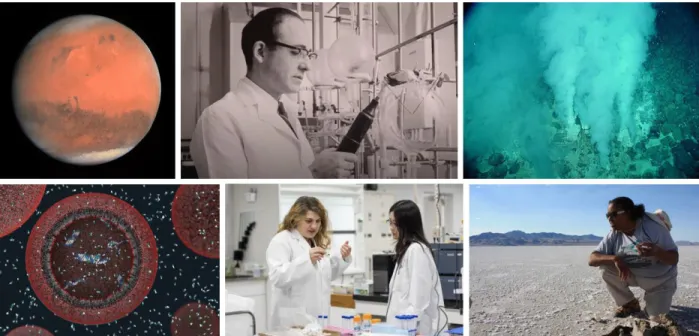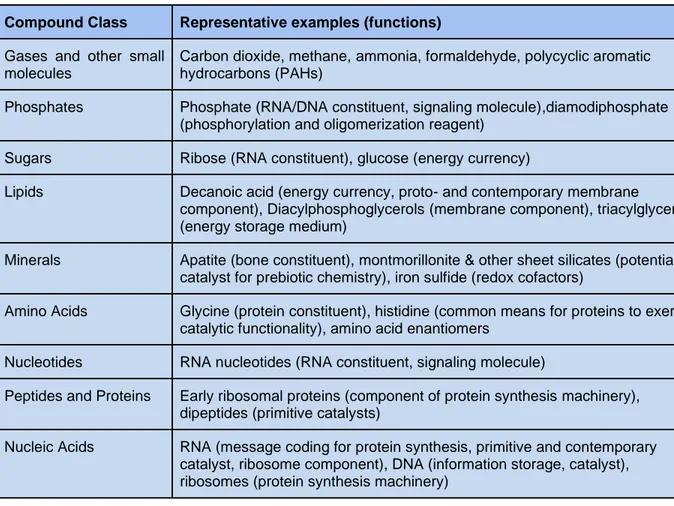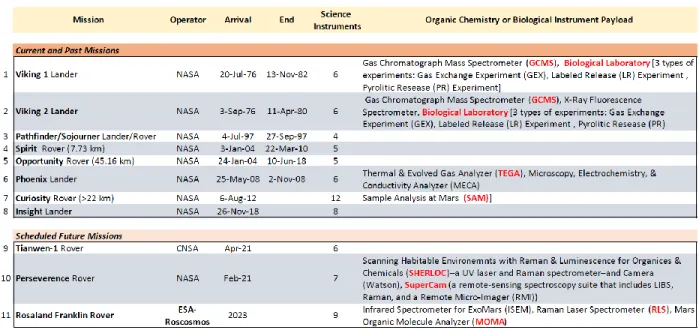HAL Id: hal-03161833
https://hal.archives-ouvertes.fr/hal-03161833
Submitted on 8 Mar 2021HAL is a multi-disciplinary open access archive for the deposit and dissemination of sci-entific research documents, whether they are pub-lished or not. The documents may come from teaching and research institutions in France or abroad, or from public or private research centers.
L’archive ouverte pluridisciplinaire HAL, est destinée au dépôt et à la diffusion de documents scientifiques de niveau recherche, publiés ou non, émanant des établissements d’enseignement et de recherche français ou étrangers, des laboratoires publics ou privés.
Astrobiology on habitable worlds: The case for
considering prebiotic chemistry in mission design
Aaron Engelhart, Jennifer Blank, Christopher Carr, Zachary Adam, Ariel
Anbar, Steven Benner, Donald Burke-Aguero, Aaron Burton, Andrew
Ellington, Michael Gaylor, et al.
To cite this version:
Aaron Engelhart, Jennifer Blank, Christopher Carr, Zachary Adam, Ariel Anbar, et al.. Astrobiology on habitable worlds: The case for considering prebiotic chemistry in mission design. 2020. �hal-03161833�
Astrobiology on habitable worlds: The case for
considering prebiotic chemistry in mission design
Lead author: Aaron E. Engelhart, University of Minnesota. Phone: 612-625-1950 E-mail: enge0213@umn.edu
Co-authors:
Jennifer G Blank, NASA Ames Research Center/Blue Marble Space Institute of Science Christopher Carr, Georgia Institute of Technology
Henderson James Cleaves, Earth-Life Science Institute Kennda Lynch, Lunar and Planetary Institute/USRA Co-signatories:
Zachary Adam, University of Arizona
Katarzyna P. Adamala, University of Minnesota Ariel D. Anbar, Arizona State University
Laura M. Barge, Jet Propulsion Laboratory David A. Baum, University of Wisconsin-Madison
Steven A. Benner, Foundation for Applied Molecular Evolution Donald H. Burke-Aguero, University of Missouri
Aaron S. Burton, NASA Johnson Space Center
Luoth Chou, NASA Goddard Space Flight Center / Georgetown University
George M. Church, Harvard Medical School/Massachusetts Institute of Technology Bruce Damer, University of California-Santa Cruz
David Deamer, University of California-Santa Cruz Andrew Ellington, University of Texas at Austin
Alberto G. Fairén, Centro de Astrobiología (CSIC-INTA), Spain Jay Forsythe, College of Charleston
Andrew Gangidine, U.S. Naval Research Laboratory Michael Gaylor, Dakota State University
Donato Giovannelli, University of Naples Federico II, Italy and Rutgers University, USA Jennifer B. Glass, Georgia Institute of Technology
Natalie Grefenstette, Santa Fe Institute Trinity L. Hamilton, University of Minnesota Betul Kacar, University of Arizona
Christine D. Keating, Pennsylvania State University Alex Longo, University of North Carolina, Chapel Hill
Irena Mamajanov, Earth-Life Science Institute/Tokyo Institute of Technology Cornelia Meinert, CNRS/University Côte d’Azur
Karan Molaverdikhani, Max Planck Institute for Astronomy Marco Moracci, National Research Council of Italy
Sandra Pizzarrello, Arizona State University
Laura E. Rodriguez, NASA Jet Propulsion Laboratory Burckhard Seelig, University of Minnesota
Jack W. Szostak, Harvard Medical School/Massachusetts General Hospital Brian D. Wade, Michigan State University
Jessica M. Weber, NASA Jet Propulsion Laboratory Loren Dean Williams, Georgia Institute of Technology Nicolle Zellner, Albion College
2
Recommendation to NASA:
NASA should invest in flight instruments that can identify and characterize prebiotically relevant classes of organic compounds, (homo)chirality, minerals, redox environments, and geochemical signatures proposed in various models for the emergence of life on Earth. The presence or absence of these constituents could support or refute competing models of Terran origins, the likelihood that similar processes operated on Mars, and the potential for life in the universe.
Introduction: The case for prebiotic chemistry in mission design
Laboratory-based studies of prebiotic chemistry - processes by which potential chemical precursors to life are produced - have provided many insights into processes by which life could have emerged on early Earth. These studies have incorporated information from many fields, including biology, organic and inorganic chemistry, mineralogy and planetary science, physics, and space science (Figure 1). They have leveraged information from each of these disciplines to identify environmental and chemical conditions on the early Earth that may have led to the emergence of life. In this white paper, we describe how
these insights provide actionable information that can inform the design of current and future space exploration missions.
Figure 1. Clockwise from upper left: True-color image of Mars captured by the OSIRIS camera instrument on the Rosetta spacecraft in 2007; Miller-Urey spark discharge experiment (photo credit: WGBH); hydrothermal white smoker, Champagne Vent, near NW summit of Eifuku Seamount (photo credit: NOAA); Astrobiologist K. Lynch of the Lunar Planetary Institute performing field studies in the Pilot Valley Basin, Utah, a planetary analog site (credit: Kennda Lynch); Irena Mamajanov & Yuki Suna, of the Earth-Life Science Institute, Tokyo, Japan, conduct prebiotic chemistry laboratory experiments (credit: Nerissa Escanlar); schematic illustration of an RNA world in protocells (credit: Janet Iwasa, U. Utah).
In particular, the presence of organic molecules that are hypothesized intermediates in prebiotic processes could serve as a “progress bar” for the emergence of life (1) (Figure 2, Table 1), especially if such intermediates accumulated in sufficient amounts to be detected. Here, hypotheses concerning prebiotic processes guide not only life detection-focused missions, while still representing a “win/win” proposition as they incorporate insights from astrobiologists and other prebiotic chemists in mission design to de-risk mission science objectives. This is true because prebiotic chemistry experiments can leverage many of the same instruments used for detection of past or present life. Finally, the insights obtained from prebiotic chemistry inform our understanding of biochemistry that is possible on other worlds. Prebiotic chemists have a long tradition of exploring diverse environments beyond aqueous solutions, including icy environments, brines (2), mineral-based systems, and hydrothermal environments. Similarly, the prebiotic chemistry community has engaged in a wide range of studies of alternative biochemistries, ranging from comparatively minor “tweaks” to the Earth-based nucleic acid/protein central dogma of biology, to wholesale reimagining of the chemistry that could possibly support life, including incorporation of other elements than those found in known life, alternative solvents other than water that can support the self-assembly of biopolymers, and alternatives to cellular life in mineral or surface environments.
Underpinning all missions seeking prebiotic chemistry or life itself is the need to improve understanding of astrochemical processes to inform the null hypothesis of exogenous delivery for studies of any planetary body. Thus, lab-based studies of cryogenic chemistry are required to elucidate the full range of chemical space accessible and occupied. Prebiotic chemistry mitigates Earth-focused bias
Historically, prebiotic chemistry has attracted investigators with a wide range of discipline expertise and competing theories. Longstanding and fruitful debate in the prebiotic chemistry community today relates to whether life on Earth emerged in a form very much like that found today, or whether a period of chemical evolution occurred early in life or pre-life before modern biochemistry emerged. The first viewpoint is an argument based on parsimony, with the position that pre-biochemistry among nucleic acids, amino acids, and lipids that look largely similar to those found in life today would simplify the chemistry required for life to emerge and thus increase the probability of life emerging (3). The second viewpoint, an argument based on molecular evolution, contends that features of modern biochemistry represent “molecular fossils” - for example, that RNA was the initial biopolymer later supplanted by the more hydrolytically stable DNA. Sugar-backbone heterogeneity and RNA/DNA chimeras could have preceded DNA and RNA that became the basis for all forms of life on our planet. Accordingly, other, now-cryptic features of prebiotic chemistry could have led to the emergence of life (4). The third prebiotic model proposes the existence of metabolic networks before DNA and RNA. Prebiotic chemistry has enhanced our understanding of what constitutes life and its properties. One widely agreed-upon hallmark of a living system is its ability to replicate (5). Accordingly, chemists and chemical biologists have labored to understand which aspects of chemistry lead to the ability to replicate, either in a template-specific fashion (as best embodied by nucleic acids) or in a form-specific way (liposome replication) (6).
4 Figure 2. Prebiotic chemistry is thought to have spanned the continuum from building blocks of biopolymers (cf. Table 1) to living organisms, including intermediate stages in which increasingly life-like assemblies and complexity emerged. Figure generated using biorender.com.
The robust debate about these issues continues in the prebiotic chemistry community today. The resulting ideas have led to a thriving scientific literature in which alternative chemistries have been explored in parallel with discoveries about extant, Earth-based biochemistry. These include reimagination of biochemical systems at a range of scales, including comparatively small modifications to, for example, the sugars and bases comprising nucleic acids (7, 8), to larger modifications, such as elimination of the charged phosphodiester linkage and replacement with neutral alternatives, including those made of protein (9–11). The astrobiology community has also considered the possibility of life that does not resemble that found on Earth, including informational polymers distinct from DNA and RNA, or the possibility that life emerged in solvents other than water (12–15). To this end, chemists and chemical biologists have created a variety of systems, both natural and decidedly unnatural (8), that act as replicators, and have in recent years developed the field of systems chemistry that in part deals with understanding the physical chemistry and kinetics of replicating systems (16).
Any given prebiotic model of life provides a null hypothesis in the search for life. Examples include exogenous meteoritic and cometary delivery of organics in the absence of planetary prebiotic processes, to atmospheric, surface, sub-aqueous, and sub-surface processes. Mars is a tractable and accessible model to evaluate different models of the origin of life, including the potential for a cyanosulfidic origin of life (17–19) versus a vent origin (20).Titan is an also amenable target to evaluate and test varying prebiotic models, and with the selection of the DragonFly Mission, it will become a more accessible target of future study (21, 22).
Table 1. Classes of Compounds Studied in Prebiotic Chemistry Experiments and their Functions Compound Class Representative examples (functions)
Gases and other small molecules
Carbon dioxide, methane, ammonia, formaldehyde, polycyclic aromatic hydrocarbons (PAHs)
Phosphates Phosphate (RNA/DNA constituent, signaling molecule),diamodiphosphate (phosphorylation and oligomerization reagent)
Sugars Ribose (RNA constituent), glucose (energy currency)
Lipids Decanoic acid (energy currency, proto- and contemporary membrane component), Diacylphosphoglycerols (membrane component), triacylglycerol (energy storage medium)
Minerals Apatite (bone constituent), montmorillonite & other sheet silicates (potential catalyst for prebiotic chemistry), iron sulfide (redox cofactors)
Amino Acids Glycine (protein constituent), histidine (common means for proteins to exert catalytic functionality), amino acid enantiomers
Nucleotides RNA nucleotides (RNA constituent, signaling molecule)
Peptides and Proteins Early ribosomal proteins (component of protein synthesis machinery), dipeptides (primitive catalysts)
Nucleic Acids RNA (message coding for protein synthesis, primitive and contemporary catalyst, ribosome component), DNA (information storage, catalyst), ribosomes (protein synthesis machinery)
Dual-use instrumentation for detection of prebiotic chemistry and life
There have been 52 scientific instrument suites that have arrived to the surface of Mars, and this total will rise to 74 when we include the payloads of scheduled missions (Table 2). Of these prior, active, and planned instruments, only 10 have had or will have the capability to identify and characterize organic compounds.
Recommendation to NASA: NASA and other space agencies should increase the proportion of science instruments to reflect the broad community interest in prebiotic chemistry and life detection.
Instrumentation seeking evidence of prebiotic chemistry and/or life on Mars has, after Viking, focused on assessing habitability (“follow the water,” “follow the energy”), including through characterization of elemental composition, as well as chemical and isotopic characterization of increasing complexity (e.g., SAM; (23)). With the advent of the Mars Perseverance Rover we are now at the cusp of being able to interrogate remotely not only atomic abundance and chemical bonds (SuperCAM (24), PIXL (25)) but also specific
6
organic moieties, e.g., detection of aromatic and aliphatic compounds via Raman (SHERLOC (26)).
Table 2. Mars Surface missions. An expanded form of this table is available online here.
Technology gaps remaining include achieving adequate sensitivity and specificity to test specific prebiotic hypotheses, as well as compatibility of such instruments with planetary protection requirements suitable for accessing regions where modern day prebiotic processes might be relevant. Instruments currently in development could enable detection of prebiotic or biotic molecules such as informational polymers, although it must be recognized that for the cyanosulfidic model, early Mars was far more ideal than present day Mars (27). Because RNAs from such an ancient prebiotic milieu would not be expected to survive to the present day (28), technologies such as biological nanopore-based sequencing of nucleic acid polymers are better suited to seeking extant life (29). Instead, prebiotic molecules capable of surviving diagenesis and long-term residence in sediments or regolith, despite natural radioactivity and other damage processes, should be sought; examples include the amino acid abundance distribution and possibly lipids. Amino acid abundances could be measured through a variety of techniques including nascent methods such as single molecule quantum electron tunneling sensors (30–33), now being developed under the PICASSO program (Electronic Life-detection Instrument for Enceladus/Europa, ELIE; personal communication, Christopher E. Carr).
In order to identify unknown chemical species, mass spectrometry will remain a critical tool. An Orbitrap mass spectrometer is one promising option (34) as it facilitates soft ionization techniques that preserve larger organic molecules and provides, higher
resolution (to resolve monatomic isobars and polyatomic interferences), Another alternative to gas chromatography for upfront separation (35) could be plasma mass spectrometry (to resolve trace element chemistry), and alternatives to gas chromatography for upfront separation (35). A key challenge will also be the ability to chemically extract many of these molecules in situ, but instrument development efforts such as the ExCALiBR extractor (36–39), are currently underway.
Takeaway: Insights from Earth-based Astrobiology
Studies of astrobiology over the past century have provided key insights into the question: How did life first emerge on Earth? Investigators have approached this topic from a diverse set of perspectives, including: 1) the environment(s) in which life may have emerged, 2) the chemical pathways that gave rise to life, 3) the possibility of alternative chemistries associated with the emergence of life, and 4) whether such chemistries were explored either on the way to modern biochemistry and represent cryptic chemical ancestors, or “dead-ends” that were outcompeted by other chemistries. These
investigations are ideally positioned to provide insights into the emergence of life on other celestial bodies. These bodies include those with more Earth-like
environments to those spanning the continuum to environments that could have supported other chemistries. These investigations have considered a range of environments, such as those found on Mars, Titan, Venus, and a range of exoplanets. Engaging the prebiotic chemistry community in mission development represents a powerful potential low- or zero-cost value-add in design of life-detection missions. Including the detection of prebiotic chemistry or pre-biosignatures in these missions would, in many cases, employ the same instrumentation required for life detection, increasing the scope and likelihood of success at low or no cost.


